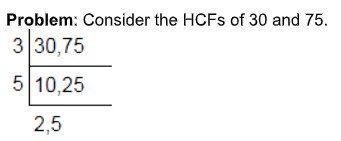What is HCF?
The Highest Common Factor (HCF) or Greatest Common Divisor (GCD) of two or more numbers is the largest positive integer that divides each of the numbers without leaving a remainder.For example, the HCF of 18 and 48 is 6, because 6 is the largest number that divides both 18 and 48 evenly.The HCF of 12 and 36 is also 12.There are a few key properties of HCF:
- The HCF of two or more numbers divides each of the numbers without a remainder
- The HCF is always less than or equal to each of the numbers
- The HCF of two or more prime numbers is always 1
Also Check: Full Form of HCF
Methods of Finding HCF
To find the HCF (Highest Common Factor) of any two numbers, you can use one of the following methods:
(i) Prime Factorization Method
(ii) Division Method
Also Check: Prime Numbers from 1 to 100
HCF Using Prime Factorization Method
Step 1: Start by expressing each number as a product of its prime factors. This process is known as prime factorization.
Step 2: Identify the common prime factors of the numbers.
Step 3: The HCF is the product of the lowest powers of all common prime factors.
Example: Find the HCF of 60 and 75.
Solution: Write each number as a product of its prime factors.
22 x 3 x 5 = 60
3 x 52= 75
Product of all common prime factors is the HCF
In this case, the common prime factors are 3 & 5.
The lowest power of 3 is 3 and 5 is 5.
So, HCF = 3 x 5 = 15
HCF By Division Method
- List the Numbers: Write the given numbers separated by commas in a horizontal line.
- Identify the Smallest Prime Factor: Determine the smallest prime number that can divide the given numbers exactly. Start dividing from the left side.
- Record the Quotients: Write down the results of the division.
- Repeat the Process: Continue this process until you are left with numbers that have no common prime factors.
- Determine the HCF: The common prime factors on the left-hand side, which divide all the numbers perfectly, will be used to find the HCF. Multiply these common prime factors to get the HCF.
Also Check: Even Numbers
Problem:Consider the HCFs of 30 and 75.

It is evident that the prime factors listed on the left side divide all the numbers completely.
Therefore, these are the common prime factors. The numbers at the bottom have no common prime factors.
Hence, the HCF is 3 × 5 = 15.
HCF by Shortcut method
Step 1: Divide the larger number by the smaller number.
Step 2: Use the remainder from step 1 as the new divisor and divide the previous divisor by it.
Step 3: Repeat this process with the new remainder.
Step 4: Continue until the remainder is zero.
Step 5: The HCF is the divisor from the last non-zero remainder step.
Frequently Asked Questions
To calculate the HCF (Highest Common Factor), you can use the prime factorization method or the division method. For the prime factorization method, write each number as the product of its prime factors, then list the common factors and take the largest one. For the division method, divide the larger number by the smaller number, then divide the divisor by the remainder, repeating until the remainder is 0. The last divisor is the HCF.
The HCF (Highest Common Factor) of 24 and 36 is 12. This is found by prime factorizing both numbers: 24 = 2 × 2 × 2 × 3 and 36 = 2 × 2 × 3 × 3. The common factors are 2 × 2 × 3, which equals 12.
To find the HCF easily, you can use the difference method. First, find the difference between the two numbers. If the difference is a factor of both numbers, it is the HCF. If not, write the difference in terms of its prime factors and check if any of these are factors of the original numbers. Repeat this process until you find the HCF.
The HCF (Highest Common Factor) of 24 and 32 is 8. This is found by prime factorizing both numbers: 24 = 2 × 2 × 2 × 3 and 32 = 2 × 2 × 2 × 2 × 1. The common factors are 2 × 2 × 2, which equals 8
The HCF (Highest Common Factor) of 24 and 32 is 8. This is found by prime factorizing both numbers: 24 = 2 × 2 × 2 × 3 and 32 = 2 × 2 × 2 × 2 × 1. The common factors are 2 × 2 × 2, which equals 8.